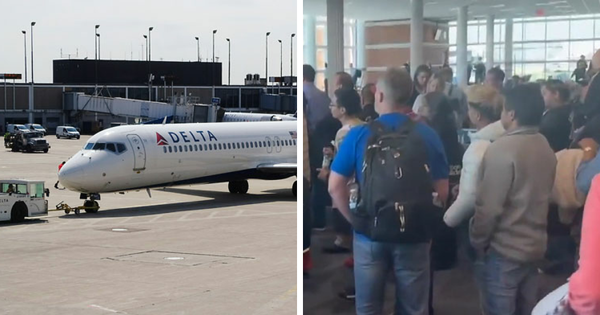Delta Air Lines reported better-than-expected first-quarter profit early Wednesday, but also said that "growth has largely stalled" amid global uncertainty around global trade. The airline plans to reduce capacity growth to align supply with demand, but said it remains "well positioned to deliver solid profitability and free cash flow for the year."
The airline reported Q1 earnings grew 2% to 46 cents per share while sales increased 3.3% to $12.978 billion. Prior to Wednesday, analyst consensus pegged quarterly profit for the S&P 500 component at 38 cents per share with revenue totaling $12.975 billion, according to FactSet. For 2025, analysts predict a 4.5% decline in annual earnings to $5.88 per share.
Delta said Wednesday that its revenue increase benefited from its premium revenue growth. The airline also saw international revenue increase mid-single-digits compared to last year. The Q1 results come after Delta Air Lines in March cut its Q1 guidance, with the airline expecting 3% to 4% revenue growth for its March-ending quarter. That was down from its January forecast for a 7% to 9% increase. The airline also lowered its earnings forecast to between 30 cents and 50 cents per share. In January, Delta expected earnings to range from 70 cents to $1 per share.
Delta stock soared 23.4% to 44.27 during Wednesday's stock market action. Peers United Airlines Holdings and American Airlines Group also both traded up more than 20% as President Donald Trump announced a 90-day pause in reciprocal tariffs for "nonretaliating countries." The S&P 500 exploded more than 8% higher, even as Trump simultaneously announced still-higher tariffs on China.
The 18 stocks in the IBD-tracked Transportation-Airline industry group have collectively dropped 38% in 2025. That puts the group at 137 out of the 197 industries ranked by IBD. Delta stock is down around 40% in 2025, after selling off 15% last week amid President Donald Trump's tariff announcement.
Delta Outlook: 'Growth Has Largely Stalled'
"While the first quarter unfolded differently than initially expected, we delivered solid profitability that was flat to prior year and is expected to lead the industry," Chief Executive Ed Bastian said Wednesday in the earnings release.
"With broad economic uncertainty around global trade, growth has largely stalled. In this slower-growth environment, we are protecting margins and cash flow by focusing on what we can control. This includes reducing planned capacity growth in the second half of the year to flat over last year while actively managing costs and capital expenditures," Bastian added.
Delta's outlook for Q2 sees earnings of $1.70 to $2.00 per share with revenue ranging from a 2% drop to a 2% increase. The airline predicts operating margins will be 11%-14%. Analysts expect Q2 EPS of $2.21, down 6% vs. Q2 2024, and revenue increasing 1.7% to $15.67 billion.
"Given the lack of economic clarity, it is premature at this time to provide an updated full-year outlook." Bastian said Wednesday.
However, Bastian added that "given our position of strength, our bias toward action and the decline in fuel prices" Delta is "positioned to deliver solid profitability and free cash flow for the year."
U.S. oil prices dropped 6% on Wednesday, trading below $56 per barrel.
Airlines Earning Season
Delta kicked off airlines earnings season on Wednesday. Fellow S&P 500 stock United Airlines reports earnings on April 15. Alaska Air Group follows on April 23 with Southwest Airlines announcing Q1 results on April 24. American Airlines is also expected to report on April 24.
"If the market can be convinced that we are not going into a broad-based consumer recession in the next 6 months and that normalized EPS at the airlines remains relatively unchanged, the 1Q/2Q reset in numbers should be a clearing event that draws a bid for the stocks," Morgan Stanley analyst Ravi Shanker wrote on Monday.
"On the other hand, if 2Q guidance goes beyond 'we have no idea' and into 'we are seeing active demand destruction even in peak season' territory, the stocks have more room for downside, back to their August lows (at least)," Shanker added of the airlines sector.
Airlines Already Revise Expectations
Prior to the Trump tariffs triggering increased recession fears last week, Delta and several other airlines already revised Q1 guidance lower.
American Airlines last month said the revenue environment has been weaker than initially expected due to softness in the domestic leisure segment, particularly in March. The company has also been affected by the Flight 5342 collision in January over the Potomac River, which resulted in 67 deaths.
American expects flat revenue for the first quarter, down from its previous outlook for 3% to 5% growth. The airline lowered its earnings guidance and now expects a loss between 60 cents and 80 cents per share. In January, American expected a loss of 20 cents to 40 cents.
Elsewhere, Southwest Airlines cut its forecast for its revenue per available seat mile, and now expects 2% to 4% growth. Southwest previously expected 5% to 7% growth.
The airline lowered the outlook for its cost per available seat mile to about 6% growth, from its prior range for a 7% to 9% increase.
With oil prices lagging, fuel prices could be one positive metric. Southwest estimates its fuel cost per gallon will range from $2.35 to $2.45. It previously expected fuel to cost $2.50 to $2.60 per gallon.
Southwest noted it has made progress on previously announced initiatives, such as assigned seating and extra legroom, which are on track to begin in Q1 2026. The company also launched its first red-eye flights last month.
Other recent initiatives include new interline agreements with Icelandair as well as an amended co-brand agreement with Chase for cardholder benefits. Southwest is pursuing additional airline partnerships, according to the SEC filing.
YOU MAY ALSO LIKE:
Is Tesla Stock A Buy Or A Sell?
Get Full Access To IBD Stock Lists And Ratings
Learning How To Pick Great Stocks? Read Investor's Corner
AI Is Fueling A 'Nuclear Renaissance.' Bill Gates And Jeff Bezos Are In The Mix.
The Lithium Price Cycle Has Bottomed. What To Expect Next For These Stocks.







